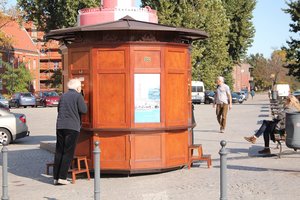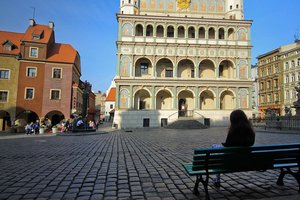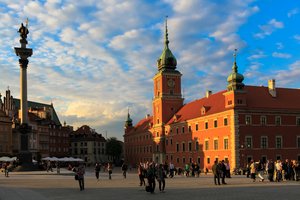Gdynia – a city of sea and dreams
A city of the sea and dreams – that is how people picture Gdynia. One would be hard pressed to find a term that better describes the nature of this enchanting port.
 The decision to build a port in Gdynia was taken after Poland regained independence in 1918. Transforming a sleepy holiday resort into one of Europe’s most modern ports was, aside from the Central Industrial Region, the biggest Polish investment project during the interwar period, a symbol of the maritime aspirations of the renascent state.
The decision to build a port in Gdynia was taken after Poland regained independence in 1918. Transforming a sleepy holiday resort into one of Europe’s most modern ports was, aside from the Central Industrial Region, the biggest Polish investment project during the interwar period, a symbol of the maritime aspirations of the renascent state.
During the the communist Polish People’s Republic, Gdynia was a window to the world; it is from here that famous tall ships - Dar Pomorza, Zawisza Czarny, Pogoria - would sail out to sea, a realisation of dreams about voyages and distant countries attainable only by the very few.
“Poland starts here,” reads an inscription on an information plaque at the end of the Southern Wharf. This 630-meter long pier jutting out into the sea is the heart of Gdynia and the most popular meeting and recreation spot. You can spend your whole day here, visiting the Gdynia Aquarium with its displays of marine flora and fauna, wandering around the near-by marina and the municipal beach or walking along the Passenger Ships Avenue paved with granite plaques commemorating the world’s most famous pleasure ships that called at the Gdynia port. But it is two unique museum-ships permanently moored here that constitute the pier’s biggest attraction.
 Dar Pomorza also called the White Frigate, a beautiful three-mast ship with a noble silhouette built in 1909 in the Hamburg shipyard, is a legend of Polish sailing. In 1929, it was bought with public donations and handed over to the State Gdynia Maritime University. For over half a century, it sailed under the Polish flag, clocking in over a half million nautical miles, completing 105 voyages (in the 1930s it was the first Polish vessel to circle the earth and sail around Cape Horn), calling at hundreds of ports and training 14,000 students. It was Poland’s sailing ambassador, taking part in tall ship races and regattas, a two time winner of the Cutty Sark Tall Ships’ Races. In 1981 it sailed off on its last voyage, to the Finnish port of Kotka.
Dar Pomorza also called the White Frigate, a beautiful three-mast ship with a noble silhouette built in 1909 in the Hamburg shipyard, is a legend of Polish sailing. In 1929, it was bought with public donations and handed over to the State Gdynia Maritime University. For over half a century, it sailed under the Polish flag, clocking in over a half million nautical miles, completing 105 voyages (in the 1930s it was the first Polish vessel to circle the earth and sail around Cape Horn), calling at hundreds of ports and training 14,000 students. It was Poland’s sailing ambassador, taking part in tall ship races and regattas, a two time winner of the Cutty Sark Tall Ships’ Races. In 1981 it sailed off on its last voyage, to the Finnish port of Kotka.
Today it is a jewel in the crown of the National Maritime Museum in Gdansk. The sightseeing route takes visitors to the tween deck, engine room, sails storehouse (Dar Pomorza could unfurl 2260 square meters of sails), cabins and officers’ mess, the commander’s room, steering posts, radio and navigation cabin and a kitchen. Preserved intact, the interiors, photographs, maps and memorabilia tell the history and describe the day-to-day life of its crew.
 Moored next to it is the ORP Błyskawica, built in 1937, the oldest preserved destroyer in the world. During WWII it participated in many combat operations, e.g. escorting convoys, supplying weapons to the French resistance or sinking German ships and shooting down planes. It was the only Polish Navy ship to be decorated with the Golden Cross of the Virtuti Militari Order (Poland’s highest military decoration for heroism and courage). Since 1976, its role has been representational and it serves as a museum-ship with the original equipment and fittings. The interior of the ship in the engine and boiler rooms make an impression even on those who are not interested in military history. On display is also an exhibition of arms, uniforms, distinctions, documents, photographs and ship models. The soldiers’ personal belongings add a human touch to the military exhibition.
Moored next to it is the ORP Błyskawica, built in 1937, the oldest preserved destroyer in the world. During WWII it participated in many combat operations, e.g. escorting convoys, supplying weapons to the French resistance or sinking German ships and shooting down planes. It was the only Polish Navy ship to be decorated with the Golden Cross of the Virtuti Militari Order (Poland’s highest military decoration for heroism and courage). Since 1976, its role has been representational and it serves as a museum-ship with the original equipment and fittings. The interior of the ship in the engine and boiler rooms make an impression even on those who are not interested in military history. On display is also an exhibition of arms, uniforms, distinctions, documents, photographs and ship models. The soldiers’ personal belongings add a human touch to the military exhibition.
NELLY KAMIŃSKA

Gdynia and the sea
Gdynia is home to many companies and scientific institutes connected with the sea, including: Nauta Shiprepair Yard, Polish Ocean Lines (carrier), Polskie Ratownictwo Okrętowe (a carrier company), the Naval Academy, the Maritime Academy, the Institute of Oceanography of the University of Gdansk, the National Marine Fisheries Research Institute, the Institute of Marine and Tropical Medicine, the Central Laboratory of Fishing Industry, and the Navy Museum.
14.07.2016







